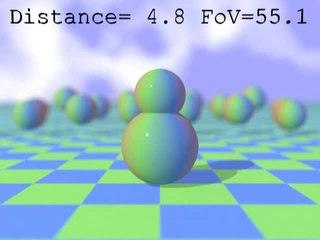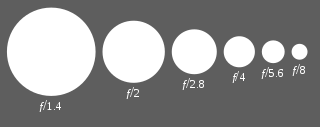Film editing

Cutting between shots taken at different times or from different perspectives is known as film editing, and is one of the central arts of filmmaking. [6]
In filmmaking and video production, a shot is a series of frames that runs for an uninterrupted period of time. [1] Film shots are an essential aspect of a movie where angles, transitions and cuts are used to further express emotion, ideas and movement. The term "shot" can refer to two different parts of the filmmaking process:
The term "shot" is derived from the early days of film production when cameras were hand-cranked, and operated similarly to the hand-cranked machine guns of the time. That is, a cameraman would "shoot" film the way someone would "shoot" bullets from a machine gun. [3]
Shots can be categorized in a number of ways. [2]
The field size explains how much of the subject and its surrounding area is visible within the camera's field of view, and is determined by two factors: the distance of the subject from the camera ("camera-subject distance") and the focal length of the lens. Note that the shorter a lens's focal length, the wider its angle of view (the 'angle' in wide-angle lens, for instance, which is "how much you see"), so the same idea can also be expressed as that the lens's angle of view plus camera-subject distance is the camera's field of view.
Three less often used field sizes are:
"Shots" referring to camera placement and angle rather than field size include: [5]

Cutting between shots taken at different times or from different perspectives is known as film editing, and is one of the central arts of filmmaking. [6]
The length of shots is an important consideration that can greatly affect a film. The purpose of editing any given scene is to create a representation of the way the scene might be perceived by the "story teller." Shots with a longer duration can make a scene seem more relaxed and slower-paced whereas shots with a shorter duration can make a scene seem urgent and faster-paced.
The average shot length (ASL) of a film is one of its cinemetrical measures. For example, The Mist has a length of 117 minutes and consists of 1292 shots, so the ASL is 5.4 seconds, while Russian Ark is a single 96-minute long take, so an ASL of 96 minutes or about 5,760 seconds, a factor of 1,000 difference.
Shots with extremely long durations are difficult to do because any error in the shot would force the filmmaker to restart from scratch, and are thus only occasionally used. Films famous for their long cuts include Francis Ford Coppola's The Godfather in which the entire first scene is a long take featuring Bonasera describing the assault on his daughter, and Alfred Hitchcock's Rope , which only cuts at the end of each reel, and does so surreptitiously so that it seems as if the whole film is one take. Orson Welles's Touch of Evil opens with a long tracking crane shot, as does Robert Altman's The Player .
In addition to Russian Ark, which was made in 2002 using digital recording technology, other films known for their extremely long takes include Stanley Kubrick's 2001: A Space Odyssey and the works of Andrei Tarkovsky starting with Solaris . Béla Tarr is also known for using very long takes consistently in his films. Joss Whedon's feature film Serenity introduces the main characters with a long take. Although Fish & Cat is a single 134-minute long take, the narrator succeeded in playing with time and including several flashbacks.

In photography, filmmaking and video production, a wide shot is a shot that typically shows the entire object or human figure and is usually intended to place it in some relation to its surroundings. These are typically shot now using wide-angle lenses. However, due to sheer distance, establishing shots and extremely wide shots can use almost any camera type.

In a movie a medium shot, mid shot (MS), or waist shot is a camera angle shot from a medium distance.
The film industry is built upon many technologies and techniques, drawing upon photography, stagecraft, music, and many other disciplines. Following is an index of specific terminology applicable thereto.

A camera is an optical instrument used to capture and store images and videos, either digitally via an electronic image sensor, or chemically via a light-sensitive material such as photographic film. As a pivotal technology in the fields of photography and videography, cameras have played a significant role in the progression of visual arts, media, entertainment, surveillance, and scientific research. The invention of the camera dates back to the 19th century and has since evolved with advancements in technology, leading to a vast array of types and models in the 21st century.

A view camera is a large-format camera in which the lens forms an inverted image on a ground-glass screen directly at the film plane. The image is viewed and then the glass screen is replaced with the film, and thus the film is exposed to exactly the same image as was seen on the screen.

In photography, angle of view (AOV) describes the angular extent of a given scene that is imaged by a camera. It is used interchangeably with the more general term field of view.

A dolly zoom is an in-camera effect that appears to undermine normal visual perception.

In photography and cinematography, a wide-angle lens refers to a lens whose focal length is substantially smaller than the focal length of a normal lens for a given film plane. This type of lens allows more of the scene to be included in the photograph, which is useful in architectural, interior, and landscape photography where the photographer may not be able to move farther from the scene to photograph it.

Cinematography is the art of motion picture photography.

A close-up or closeup in filmmaking, television production, still photography, and the comic strip medium is a type of shot that tightly frames a person or object. Close-ups are one of the standard shots used regularly with medium and long shots. Close-ups display the most detail, but they do not include the broader scene. Moving toward or away from a close-up is a common type of zooming. A close up is taken from head to neck, giving the viewer a detailed view of the subject's face.

In photography and cinematography, perspective distortion is a warping or transformation of an object and its surrounding area that differs significantly from what the object would look like with a normal focal length, due to the relative scale of nearby and distant features. Perspective distortion is determined by the relative distances at which the image is captured and viewed, and is due to the angle of view of the image being either wider or narrower than the angle of view at which the image is viewed, hence the apparent relative distances differing from what is expected. Related to this concept is axial magnification – the perceived depth of objects at a given magnification.

Deep focus is a photographic and cinematographic technique using a large depth of field. Depth of field is the front-to-back range of focus in an image, or how much of it appears sharp and clear. In deep focus, the foreground, middle ground, and background are all in focus.
This article contains a list of cinematic techniques that are divided into categories and briefly described.
Camera coverage, or coverage, is the amount and kind of footage shot used to capture a scene in filmmaking and video production. The film editor uses coverage in post-production to assemble the final cut.
The camera angle marks the specific location at which the movie camera or video camera is placed to take a shot. A scene may be shot from several camera angles simultaneously. This will give a different experience and sometimes emotion. The different camera angles will have different effects on the viewer and how they perceive the scene that is shot. There are a few different routes that a camera operator could take to achieve this effect.

The over-the-shoulder shot is a camera angle used in film and television, where the camera is placed above the back of the shoulder and head of a subject. This shot is most commonly used to present conversational back and forth between two subjects. With the camera placed behind one character, the shot then frames the sequence from the perspective of that character. The over-the-shoulder shot is then utilised in a shot-reverse-shot sequence where both subject's OTS perspectives are edited consecutively to create a back and forth interplay, capturing dialogue and reactions. This inclusion of the back of the shoulder allows audiences to understand the spatial relationships between two subjects, while still being able to capture a closer shot of each subject’s facial expression. In film and television, the filmmaker or cinematographer’s choice of an OTS shot’s camera height, the use of focus and lenses affect the way audiences interpret subjects and their relationships to others and space.

An ultra wide-angle lens is a lens whose focal length is shorter than that of an average wide-angle lens, providing an even wider view. The term denotes a different range of lenses, relative to the size of the sensor in the camera in question.
Articles related to the field of motion pictures include:
In filmmaking and television production, zooming is the technique of changing the focal length of a zoom lens during a shot – this technique is also called a zoom. The technique allows a change from close-up to wide shot during a shot, giving a cinematographic degree of freedom. But unlike changes in camera position, zooming does not change the perspective ; it only magnifies or reduces the size of the entire image as a whole.
This glossary of motion picture terms is a list of definitions of terms and concepts related to motion pictures, filmmaking, cinematography, and the film industry in general.